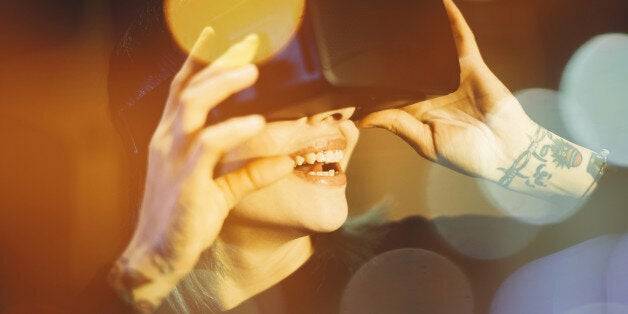

Home Virtual Reality has seemingly been looming on the horizon for three decades, ever since VPL Research founder Jaron Lanier announced the EyePhone device which retailed for just short of $10,000. But motion sickness, and the astronomical price, pushed the technology into the wilderness.

The VPL EyePhone from 1989. Image: VPL Research https://vrwiki.wikispaces.com/
This year, home Virtual Reality re-entered mainstream consciousness with no less than five new devices under the Christmas tree, ranging from premium technology room-scale experiences like HTC Vive (think Star Trek's Holodeck) to more accessible smartphone-based products such as Google Daydream and Samsung Gear, and a price range from £12 (Google Cardboard) to £689 (HTC Vive). Facebook founder Mark Zuckerberg calls it:
"The next major computing platform that will come after mobile"
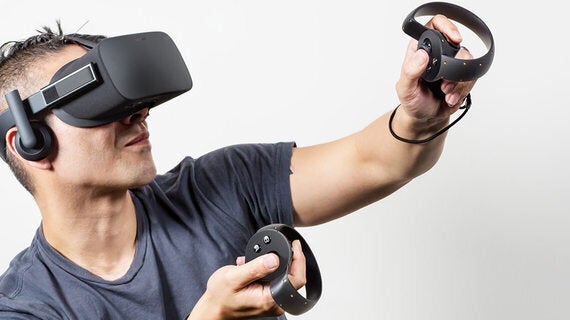
The Oculus Rift headset with the Oculus Touch hand controllers. Image: Oculus VR https://www3.oculus.com/en-us/rift/
With these new devices, it will be interesting to observe which one finds most favour in 2017: Will Facebook-owned Oculus Rift make use of its technology and social media real-estate to market its pioneering product to the masses, or will Sony's Playstation VR deliver the fun games to make VR a genuine prospect for a world of console gamers? Will people prefer affordability and portability with Samsung's Gear over the need for a tricky room-based setup with the HTC Vive, arguably the most immersive and wow device of all?
At its core, Virtual Reality remains a gaming technology. However all of the various devices are equally adept at providing amazing storytelling experiences, 360° music videos, or plunging the user into historic galleries and exotic worlds. Entering a famous Vincent Van Gogh painting in Borrowed Light Studios' "The Night Café" is, in equal measures, beautiful and surreal.

Borrowed Light Studios' "The Night Café is a unique experience allowing you to walk around a Café inspired by the famous painting from Van Gogh. Image: Borrowed Light Studios http://www.borrowedlightvr.com/the-night-cafe/
As the user base is small, the market for "Triple A" gaming titles lasting hundreds of hours is minimal. The fortunate side-effect is a booming market for short experiences and quirkier games such as "Accounting" from the Crows Crows Crows Studio which are both enjoyable and affordable. But there is still the odd zombie shooter, and zombies jumping up on you in virtual reality is very, very frightening. Beyond slaughtering undead hordes, are there more constructive applications of virtual reality technology? Yes, and the possibilities are endless....
Education and Training
Virtual Reality has always been a prospect for training in professions where peoples' lives and health are at stake. Simulators are already used to train pilots dealing with unexpected events, but the opportunity for more convenient home practice can only be a positive development.
Medical professionals can learn interventions for the operating room, emergency department or clinic, both challenging and more routine. The Miami Children's Hospital, for example, is developing medical instructional software for basic procedures such as nasogastric tube insertion and starting an IV drip, with the aim of educating doctors as well as patients. Medical and nursing students can also learn their subject with more context than a book, for example by interacting with a "live" anatomical dissection table.
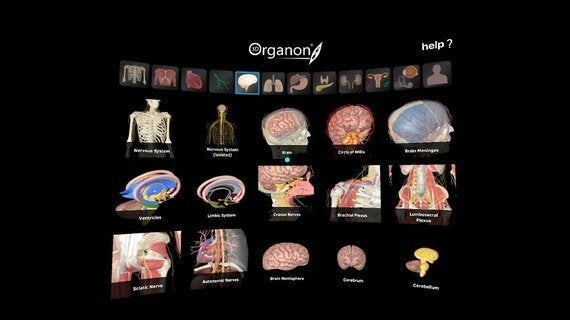
Organon VR Anatomy on the Oculus Rift makes learning anatomical structures more vivid and helps the understanding of spatial relationship between them. Image: Author's Own http://www.3dorganon.com/site/
Over the past decade, there has been an explosion in the use of simulation medicine, particularly in cardiopulmonary resuscitation and life support where it provides a much more realistic way of portraying a scenario than a mannequin and actors, and where it provides more for assessment: Gestures, eye movements, metrics and real-time feedback are more useful assessors of these skills than a written examination.
For surgical training, VR is increasingly being proposed for the learning of minimally-invasive surgical procedures. It allows a realistic operating room environment, including interaction with colleagues, but in a safer environment where mistakes are not going to cause any harm. Bimanual tool handles and force feedback can mimic surgical tools - although it will take a while for this to be accurate enough to use at home, to the level of devices such as the NeuroTouch - a commercially available brain surgery simulator. New developments in tracking technologies such as Microsoft's Handpose (which records complex hand movements) may add more intricacy to VR surgery training.
Virtual Reality is not limited to learning practical skills. Even attributes like empathy can be augmented through the headsets. Embodied Labs has designed a VR program called "We Are Alfred" which gives medical students, many of whom are in their twenties, an insight into experiencing the life of a 74 year-old man with audiological and visual problems. Providing the experience and learning the patient's perspective can be invaluable in how the students develop as medical professionals.
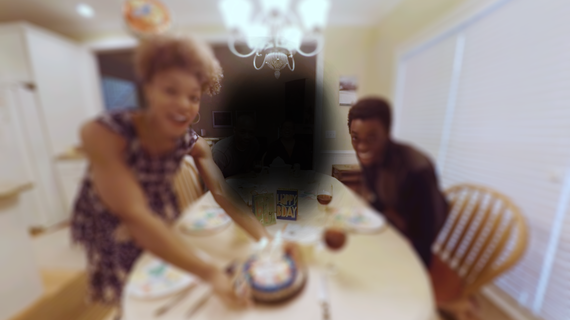
Embodied Labs' "We Are Alfred" allows students to experience the life of a 74 year-old with visual and audiological problems. Image: Embodied Labs http://www.embodiedlabs.com/
The complete audiovisual immersion provided by Virtual Reality can conjure or awaken emotions which users may not have been aware of. This has been used to good effect in journalism, such as The Guardian's award-winning 6x9 experience of solitary confinement and film-maker Nonny de la Pena's Project Syria which inserts the viewer into the plight of Syrian child refugees.
The founder of Oculus VR Palmer Luckey, affirms that this immersive power of Virtual Reality can be a medium for social change, through its ability to put you in places "in a much more real way". Virtual reality campaigns following the 2015 Nepal Earthquake and The Dolphin Project (Both Huffington Post's RYOT) have had a palpable impact on awareness. A recent AT&T campaign in the United States sees the user driving a car through residential neighbourhoods and ending up causing a tragedy whilst texting. The feedback following this emotive exercise showed that people who had the VR experience consciously removed their phones before driving.
New ways of working
Meetings and conferences are set to transform from the often vaguely distant videoconference to VR meetings. The social games and experiences on this years' devices have highlighted how much more connected people feel when they are in a shared VR space than a 2-dimensional screen. Be it event/product marketing, site inspections, interviews or negotiations, the presence and interactivity afforded by Virtual Reality will see it slowly replace Skype as "the next best thing" to physical contact.
In the field of surgery, earlier this year, Dr Shafi Ahmed performed bowel surgery which was live-streamed for anyone to "jump into the operating theatre". With improvements in haptic devices, performing remote surgery may become a reality sooner than we would have expected.
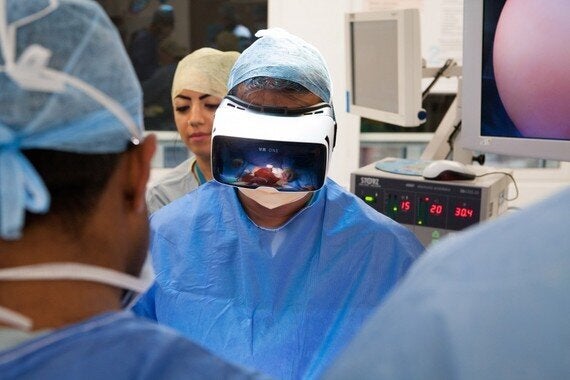
Surgery streamed in Virtual Reality. Image: Medical Realities http://www.medicalrealities.com/
Tests and Therapies
Diagnosis of illness lends itself to Virtual Reality, particular for conditions in which visual assessment is important such as Parkinson's Disease and Multiple Sclerosis. A test developed by Tomsk Polytechnic and Siberian State Universities in Russia uses cheap headsets and Microsoft Kinect sensors to monitor people's movements in virtual environments. Neurologists are then able to make earlier diagnoses and start rehabilitation. Indeed, the ability to see a doctor face-to-face from distance was one of the motivations for Facebook's Mark Zuckerberg when he purchased the Oculus VR company.
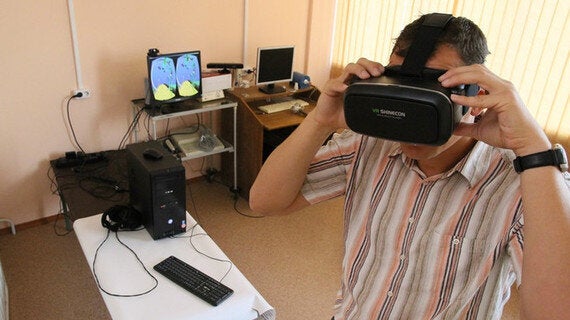
Virtual Reality being used to diagnose Parkinson's Disease. Image: Tomsk Polytechnic University http://tpu.ru/en/news-events/914/
Oculus founder Palmer Luckey first identified the potential of VR in rehabilitation whilst working with a team of therapists at the University of Southern California, helping military veterans who suffered from post-traumatic stress disorder by providing exposure therapy. This involved recreating battlefield episodes but allowing the guidance and support of a trained therapist to help identify and address the psychological trigger for illness. He said that this was when he first identified that virtual reality can be an important new therapy method: It can make a significant difference in people's lives.
Virtual reality has been shown to be beneficial in rehabilitation after strokes, particularly in improving upper limb strength and in re-learning activities of daily living. There have also been potential benefits observed in helping motor learning in children with cerebral palsy. It can become a key weapon in the rehabilitation arsenal for physiotherapists and occupational therapists over the next decade, changing the face of rehabilitation for all kinds of diseases.
Virtual Reality is no longer in its infancy. It has hit the mainstream and is here to stay. Let's use it to improve our world.
HuffPost UK Tech is running a two-week focus on our Tech For Good campaign, which aims to highlight the technology that is driving social change and making a positive, long-lasting difference to our world. If you'd like to blog on our platform around this topic, email ukblogteam@huffingtonpost.com with a summary of who you are and what you'd like to blog about.
